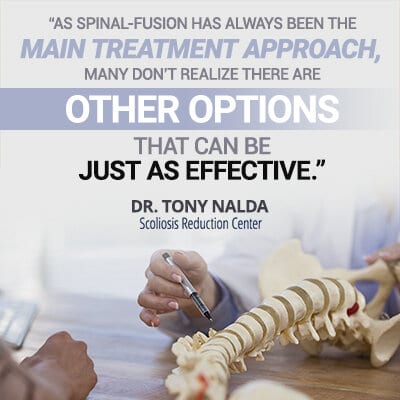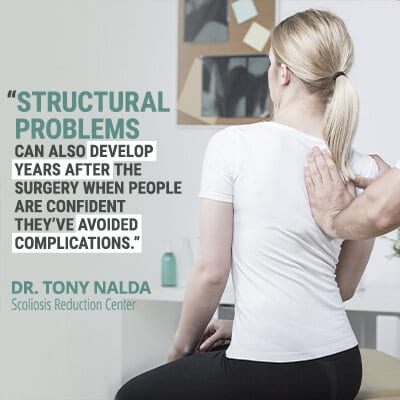Any surgery has risks and potential complications. When it comes to scoliosis surgery, many people don’t realize that risk factors don’t just apply to the surgery itself, but what happens after.
Why so Many People Opt for Scoliosis Surgery
When someone is diagnosed with scoliosis, this means they have an abnormal curvature to their spine. With the exception of a few types of the condition with known causes such as congenital, neuromuscular, traumatic or degenerative, 80 percent of known diagnosed scoliosis cases have no known cause.
In addition to such a large number of cases with no known cause, there is no known cure, and the condition is progressive. That being said, there are many ways to manage and live with the condition by preventing progression.
Different Approaches
My scoliosis-specific chiropractic-centered approach involves customizing treatment plans to each individual patient. My team and I work closely with our patients and their caregivers with the end-goal of achieving a reduction and stopping or slowing progression, without undergoing invasive surgery.

While more and more people are educating themselves on the merits of my approach here at the Scoliosis Reduction Center®, getting scoliosis surgery is still a popular choice for treating the condition. This is the case for a few reasons. In terms of straightening a crooked spine, spinal-fusion surgery can achieve that, which is what many people with scoliosis are fixated on.
As spinal-fusion has always been the main treatment approach, many don’t realize there are other options that can be just as effective.
Another reason is if a patient finds themselves on the traditional treatment path, that strategy involves a lot of monitoring the condition until it progresses to a point where surgery is recommended as the ‘best’ option.
While spinal-fusion is successful in terms of aligning a spine, there are a number of other factors that are equally important and life-changing to consider.
What Happens During Scoliosis Surgery
Most scoliosis surgeries involve using hooks, screws, and rods that are attached to the spine. The rods are used to realign areas of the spine to reduce curvatures. Surgeons can also graft bone or bone-like material to the vertebrae being fused.
Depending on the condition, sometimes multiple surgeries are needed. There is what’s called an anterior-and-posterior approach where they go in through the front to cut the ligaments and loosen the spine, and in a separate surgery, they go in through the back to install the actual hardware.
Spinal-fusion surgery involves the removal of discs that are important to human anatomy. As discs don’t particularly play a role in the body’s functionality, they can be removed somewhat casually. The thing I want to point out is that while disc removal doesn’t impact some people, it can significantly impact others.
The spinal discs act as shock absorbers, so if a person who has had spinal discs removed experiences an intense trauma, damage can occur and cause further complications. If a person undergoes spinal-fusion surgery and is in an automobile accident, the force of that accident is transferred to the rigid surgical rods, rather than the absorbent spinal discs. This can cause significant damage to the body and in extreme cases can cause the spine to break.
Spinal-Fusion Surgery and Mobility Changes
As referenced earlier, many people considering spinal-fusion surgery as a treatment option for their scoliosis are focused on the surgery itself, rather than considering what bodily changes they will be living with after the surgery.
An important factor to consider is that although the surgery can straighten a crooked spine, it doesn’t return the body to its pre-scoliosis state; nothing can do that. In fact, in terms of mobility and flexibility, patients can experience a noticeable decrease in mobility post-surgery that can impact their quality of life.
While some patients return to somewhat normal states of mobility post-surgery, studies have shown that there is an average decrease in mobility of 25 percent. Additional studies have shown that these decreases in mobility are still present after 20 years.
When I think of the many patients I’ve seen over the years, I can say with confidence that those who come to me after undergoing spinal-fusion surgery are definitely living with less mobility than my patients undergoing functional chiropractic-centered treatment.
Recovery After Scoliosis Surgery
The more invasive a surgery is, the longer its recovery time generally is. As a complex and invasive procedure, people should be prepared for the type of recovery time and healing involved with spinal-fusion surgery.
The rods installed during surgery act as splints that hold the spine in a straight alignment while fusion takes place. Full fusion can take up to a year, and once it’s complete, the recently-fused bone prevents the spine from curving abnormally. Those rods will remain in the body after as removing them would require an additional invasive surgery.
In the few weeks following the surgery, patients are not allowed to bend, twist, lift, drive, or partake in numerous physical activities. During this time, patients will need a lot of assistance to care for themselves.
The incision site has to be kept clean and dry to prevent infection, and narcotics are most often prescribed to manage pain. After a patient has gone for their first follow-up appointment to check their healing, some of the movement restrictions can be lifted and a plan moving forward will be discussed.
Life After the First Follow-Up Appointment
While certain restrictions will be removed if healing is where it should be, precautions will still need to be taken. Patients can once again engage in some physical activities and can wean themselves off of any pain-relief medication they are on.
Generally, six weeks after surgery, X-rays are taken to monitor how the spine is healing. If things look good, surgeons will lift the driving restriction and inform the patient that they can resume more physical activities.
Most people’s fusion is complete between six and twelve months after the surgery. At this point, they will be able to resume most activities. However, while the fusion process might be complete, that doesn’t mean healing from any additional surgical trauma has taken place; this can take up to two years.
People never really fully recover from spinal-fusion surgery as they will be living with the surgical hardware in their bodies, most likely, for the rest of their lives. In the event that an infection occurs at the site of fusion or around any hardware, or there is a hardware breakdown, additional surgeries will be needed down the road.
Risks of Scoliosis Surgery
In addition to the risk of decreased mobility after scoliosis surgery, there are, of course, additional risks associated with the surgery itself:
- Paraplegia – loss of movement/feeling in the lower body and legs
- Excessive blood loss
- Blood clots
- Fusion doesn’t occur
- Cerebrospinal fluid leak
- Hardware failure

If complications occur such as hardware-failure or the fusion doesn’t take place, this can result in the continued progression of the condition and the need for subsequent surgeries.
Structural problems can also develop, years after the surgery, when people are confident they’ve avoided complications. Due to the inflexibility of the spine post-surgery, the discs directly above and below the site of fusion can be subjected to increased strain. This can speed up the natural degenerative effects that occur with aging and, again, result in subsequent surgeries.
Financial Risks of Scoliosis Surgery
Let’s not forget the financial risks of spinal-fusion surgery. Every case is different as variables like surgeon fees, time in the operating room, medications, recovery time in hospital, condition severity, and whether or not complications emerge all factor into the final cost.
On average, spinal-fusion surgery costs approximately $110,000, but with the aforementioned fluctuating variables, it can easily increase up to $250,000.
With 60 percent of bankruptcy cases in the United States caused by medical debt, the financial risks are very real life-changing factors that should be taken into account when choosing a potential treatment plan.
The Emotional Risks of Scoliosis Surgery
One of the biggest challenges that patients discuss with me post-surgery is the emotional stress they weren’t expecting. While many activities are perfectly safe for people who have experienced successful spinal-fusion, there are still certain activities, like riding a roller coaster, that are not recommended.
Patients experiencing significant mobility decreases also find it difficult to know what new activities they should try or avoid.
Many people struggle with the emotional weight of fearing the rods will snap or screws will come loose; this is a possibility when it comes to trauma. The rigidity caused by the rods don’t allow for much shock absorption in instances where a jarring motion is experienced; this can cause damage to the spine, or even death in extreme cases.
Conclusion
While spinal-fusion surgery can help realign a crooked spine, it comes at a price. The rigidity that comes as a result of the spine being held in position can come with significant decreases in mobility and flexibility.
While many people think of spinal-fusion surgery as a cure for their scoliosis, this is a dangerous assumption. Scoliosis is a progressive condition with no known cure. While this is hard to accept, people need to realize that a scoliosis diagnosis means living with the condition for their entire lives.
Even with undergoing spinal-fusion surgery, that doesn’t mean the patient is free of physical restrictions and discomfort. Some people regret the limitations they are left with after spinal-fusion surgery and wonder if there was a better path of treatment.
I wrote Scoliosis Hope to inform people of the other treatment path that’s available to them. While my chiropractic-centered approach involves dedication and hard work, I’ve had the privilege of seeing my patients not only manage their condition without surgery, but thrive with it.





